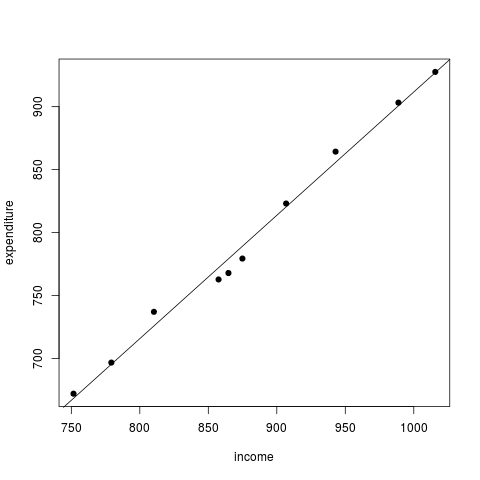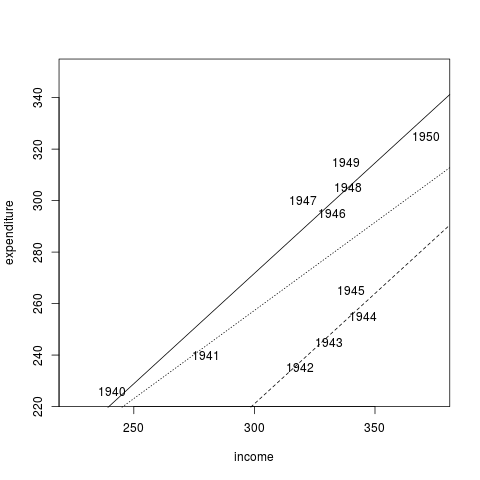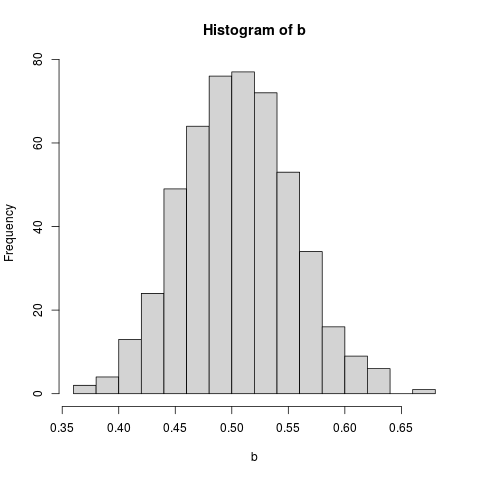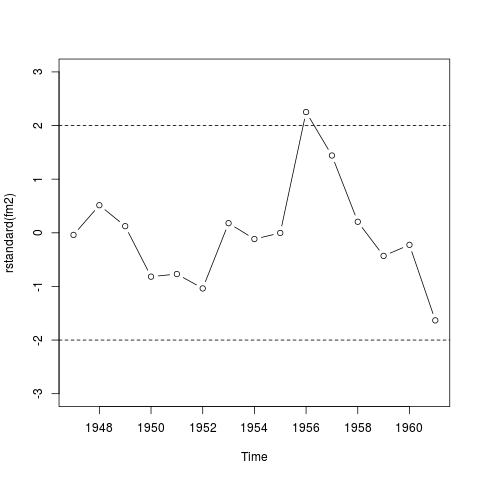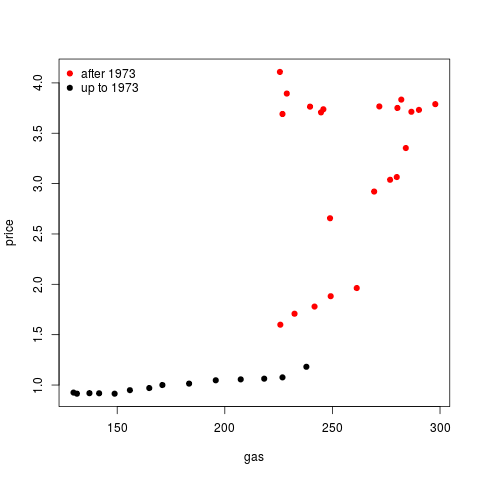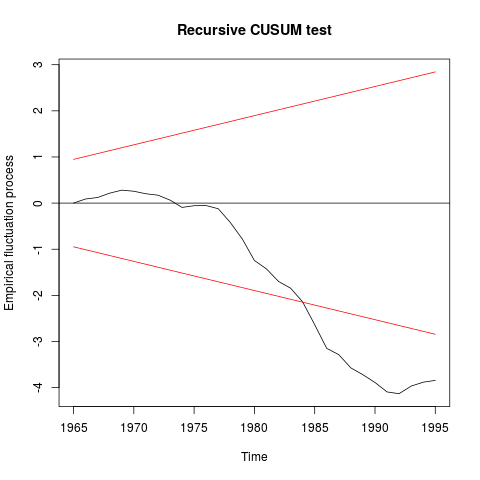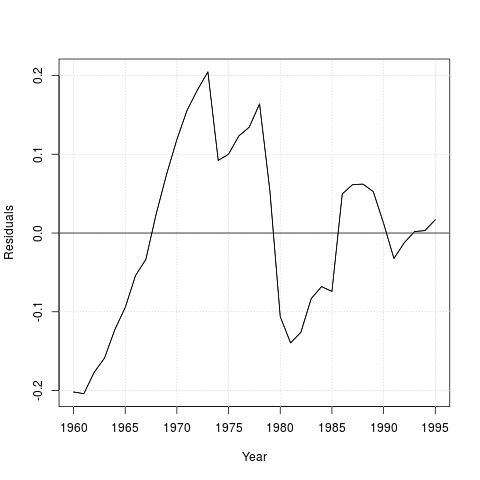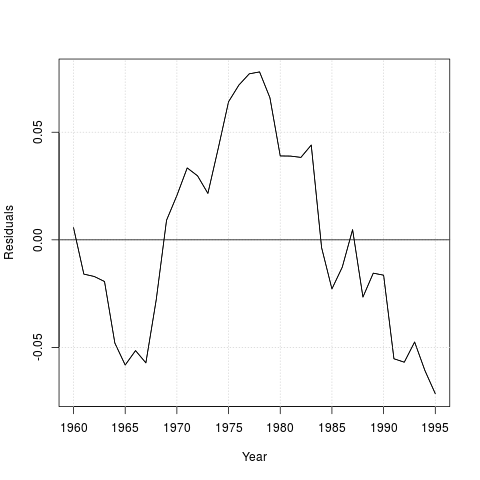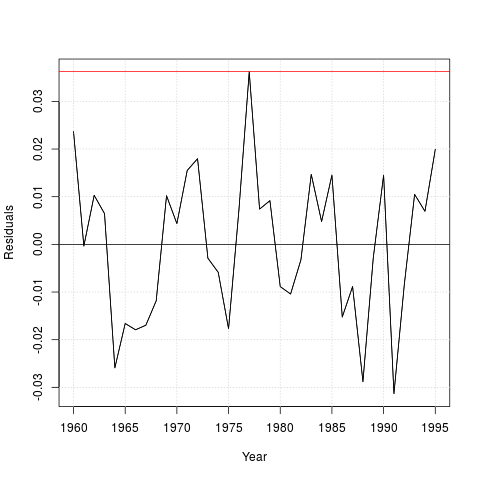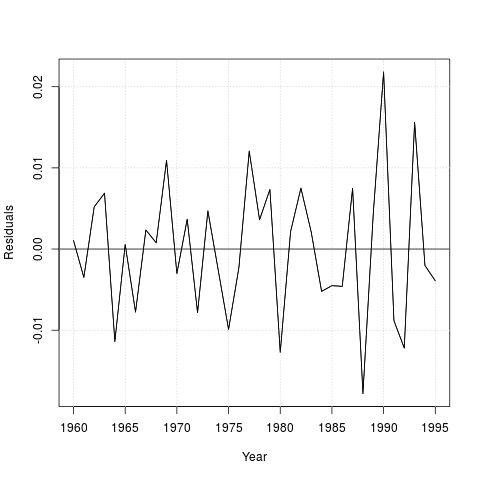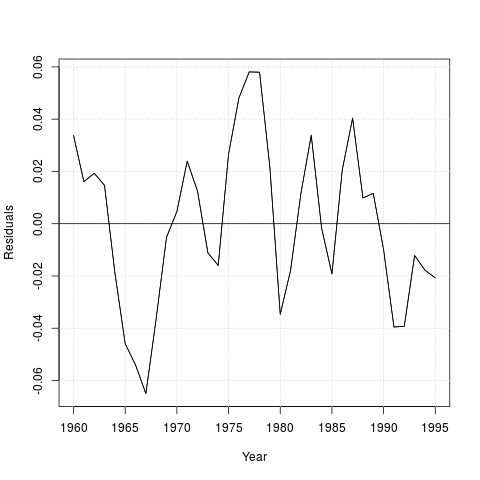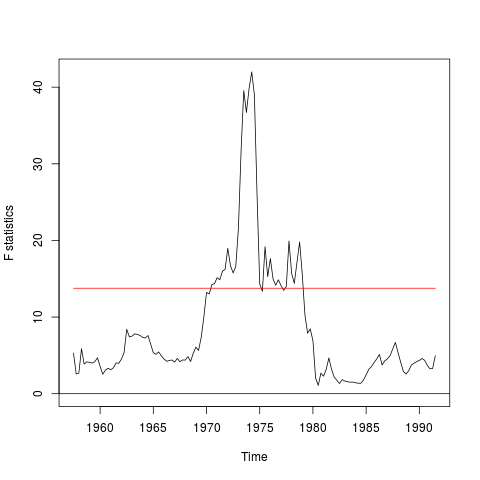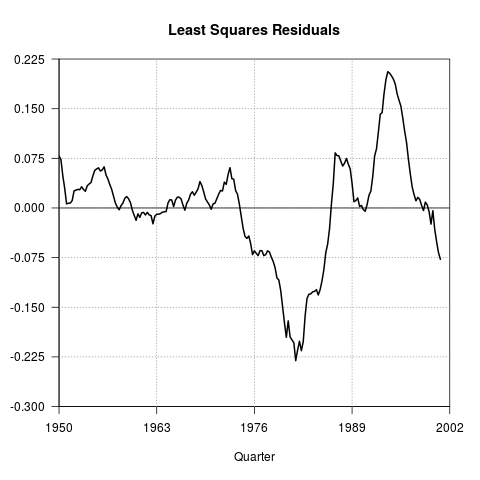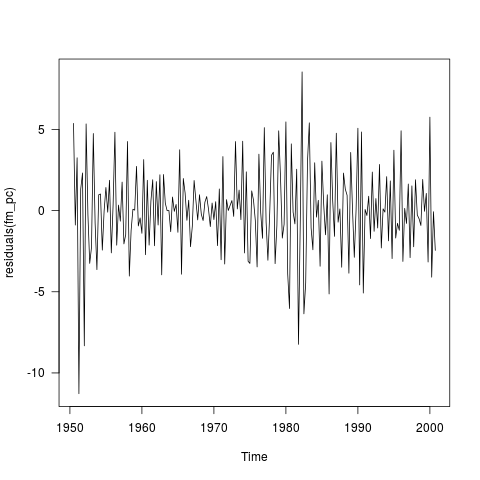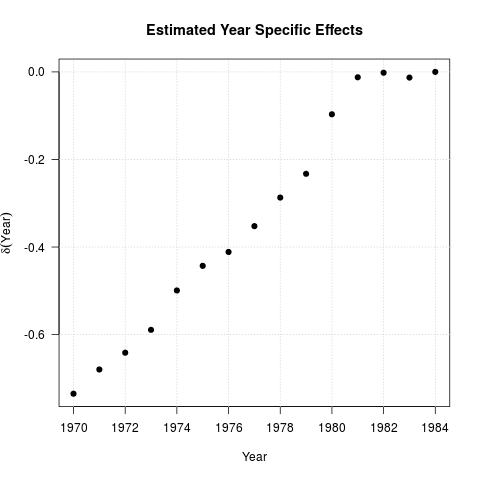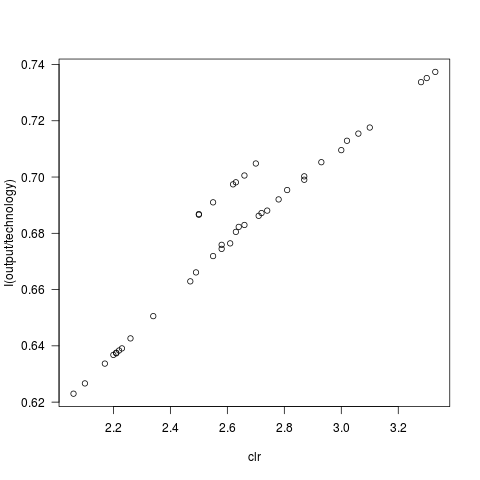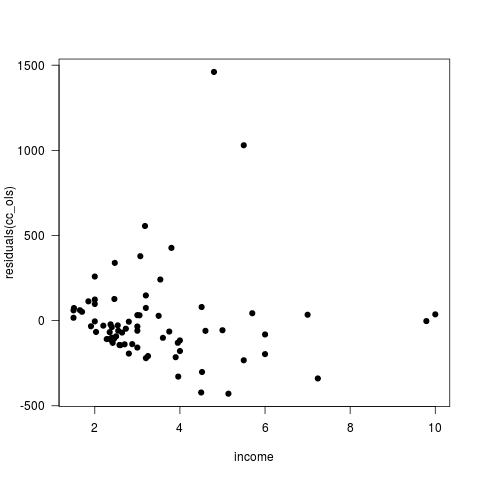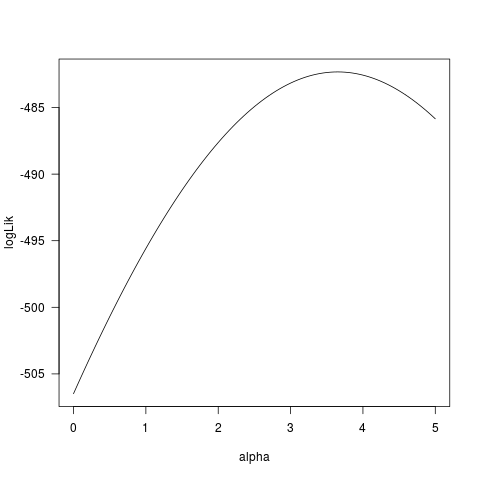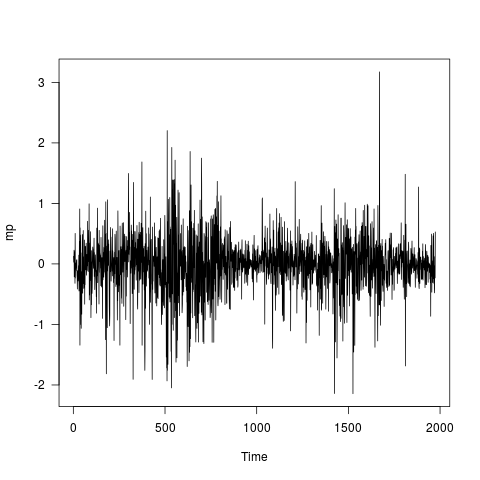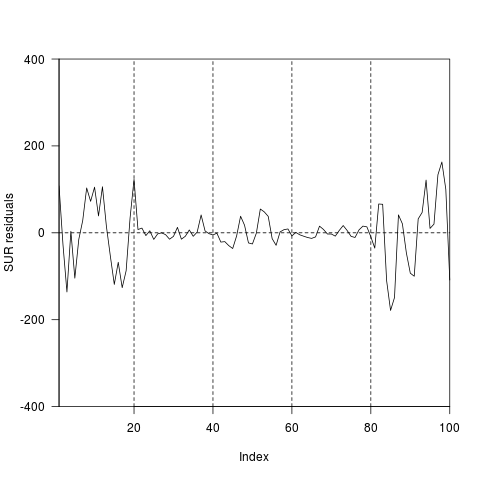Supported by Dr. Osamu Ogasawara and  providing providing  . . |
|
Last data update: 2014.03.03 |
Data and Examples from Greene (2003)DescriptionThis manual page collects a list of examples from the book. Some solutions might not be exact and the list is certainly not complete. If you have suggestions for improvement (preferably in the form of code), please contact the package maintainer. ReferencesGreene, W.H. (2003). Econometric Analysis, 5th edition. Upper Saddle River, NJ: Prentice Hall. URL http://pages.stern.nyu.edu/~wgreene/Text/tables/tablelist5.htm. See Also
Examples
#####################################
## US consumption data (1970-1979) ##
#####################################
## Example 1.1
data("USConsump1979", package = "AER")
plot(expenditure ~ income, data = as.data.frame(USConsump1979), pch = 19)
fm <- lm(expenditure ~ income, data = as.data.frame(USConsump1979))
summary(fm)
abline(fm)
#####################################
## US consumption data (1940-1950) ##
#####################################
## data
data("USConsump1950", package = "AER")
usc <- as.data.frame(USConsump1950)
usc$war <- factor(usc$war, labels = c("no", "yes"))
## Example 2.1
plot(expenditure ~ income, data = usc, type = "n", xlim = c(225, 375), ylim = c(225, 350))
with(usc, text(income, expenditure, time(USConsump1950)))
## single model
fm <- lm(expenditure ~ income, data = usc)
summary(fm)
## different intercepts for war yes/no
fm2 <- lm(expenditure ~ income + war, data = usc)
summary(fm2)
## compare
anova(fm, fm2)
## visualize
abline(fm, lty = 3)
abline(coef(fm2)[1:2])
abline(sum(coef(fm2)[c(1, 3)]), coef(fm2)[2], lty = 2)
## Example 3.2
summary(fm)$r.squared
summary(lm(expenditure ~ income, data = usc, subset = war == "no"))$r.squared
summary(fm2)$r.squared
########################
## US investment data ##
########################
data("USInvest", package = "AER")
## Chapter 3 in Greene (2003)
## transform (and round) data to match Table 3.1
us <- as.data.frame(USInvest)
us$invest <- round(0.1 * us$invest/us$price, digits = 3)
us$gnp <- round(0.1 * us$gnp/us$price, digits = 3)
us$inflation <- c(4.4, round(100 * diff(us$price)/us$price[-15], digits = 2))
us$trend <- 1:15
us <- us[, c(2, 6, 1, 4, 5)]
## p. 22-24
coef(lm(invest ~ trend + gnp, data = us))
coef(lm(invest ~ gnp, data = us))
## Example 3.1, Table 3.2
cor(us)[1,-1]
pcor <- solve(cor(us))
dcor <- 1/sqrt(diag(pcor))
pcor <- (-pcor * (dcor %o% dcor))[1,-1]
## Table 3.4
fm <- lm(invest ~ trend + gnp + interest + inflation, data = us)
fm1 <- lm(invest ~ 1, data = us)
anova(fm1, fm)
## Example 4.1
set.seed(123)
w <- rnorm(10000)
x <- rnorm(10000)
eps <- 0.5 * w
y <- 0.5 + 0.5 * x + eps
b <- rep(0, 500)
for(i in 1:500) {
ix <- sample(1:10000, 100)
b[i] <- lm.fit(cbind(1, x[ix]), y[ix])$coef[2]
}
hist(b, breaks = 20, col = "lightgray")
###############################
## Longley's regression data ##
###############################
## package and data
data("Longley", package = "AER")
library("dynlm")
## Example 4.6
fm1 <- dynlm(employment ~ time(employment) + price + gnp + armedforces,
data = Longley)
fm2 <- update(fm1, end = 1961)
cbind(coef(fm2), coef(fm1))
## Figure 4.3
plot(rstandard(fm2), type = "b", ylim = c(-3, 3))
abline(h = c(-2, 2), lty = 2)
#########################################
## US gasoline market data (1960-1995) ##
#########################################
## data
data("USGasG", package = "AER")
## Greene (2003)
## Example 2.3
fm <- lm(log(gas/population) ~ log(price) + log(income) + log(newcar) + log(usedcar),
data = as.data.frame(USGasG))
summary(fm)
## Example 4.4
## estimates and standard errors (note different offset for intercept)
coef(fm)
sqrt(diag(vcov(fm)))
## confidence interval
confint(fm, parm = "log(income)")
## test linear hypothesis
linearHypothesis(fm, "log(income) = 1")
## Figure 7.5
plot(price ~ gas, data = as.data.frame(USGasG), pch = 19,
col = (time(USGasG) > 1973) + 1)
legend("topleft", legend = c("after 1973", "up to 1973"), pch = 19, col = 2:1, bty = "n")
## Example 7.6
## re-used in Example 8.3
## linear time trend
ltrend <- 1:nrow(USGasG)
## shock factor
shock <- factor(time(USGasG) > 1973, levels = c(FALSE, TRUE), labels = c("before", "after"))
## 1960-1995
fm1 <- lm(log(gas/population) ~ log(income) + log(price) + log(newcar) + log(usedcar) + ltrend,
data = as.data.frame(USGasG))
summary(fm1)
## pooled
fm2 <- lm(
log(gas/population) ~ shock + log(income) + log(price) + log(newcar) + log(usedcar) + ltrend,
data = as.data.frame(USGasG))
summary(fm2)
## segmented
fm3 <- lm(
log(gas/population) ~ shock/(log(income) + log(price) + log(newcar) + log(usedcar) + ltrend),
data = as.data.frame(USGasG))
summary(fm3)
## Chow test
anova(fm3, fm1)
library("strucchange")
sctest(log(gas/population) ~ log(income) + log(price) + log(newcar) + log(usedcar) + ltrend,
data = USGasG, point = c(1973, 1), type = "Chow")
## Recursive CUSUM test
rcus <- efp(log(gas/population) ~ log(income) + log(price) + log(newcar) + log(usedcar) + ltrend,
data = USGasG, type = "Rec-CUSUM")
plot(rcus)
sctest(rcus)
## Note: Greene's remark that the break is in 1984 (where the process crosses its boundary)
## is wrong. The break appears to be no later than 1976.
## Example 12.2
library("dynlm")
resplot <- function(obj, bound = TRUE) {
res <- residuals(obj)
sigma <- summary(obj)$sigma
plot(res, ylab = "Residuals", xlab = "Year")
grid()
abline(h = 0)
if(bound) abline(h = c(-2, 2) * sigma, col = "red")
lines(res)
}
resplot(dynlm(log(gas/population) ~ log(price), data = USGasG))
resplot(dynlm(log(gas/population) ~ log(price) + log(income), data = USGasG))
resplot(dynlm(log(gas/population) ~ log(price) + log(income) + log(newcar) + log(usedcar) +
log(transport) + log(nondurable) + log(durable) +log(service) + ltrend, data = USGasG))
## different shock variable than in 7.6
shock <- factor(time(USGasG) > 1974, levels = c(FALSE, TRUE), labels = c("before", "after"))
resplot(dynlm(log(gas/population) ~ shock/(log(price) + log(income) + log(newcar) + log(usedcar) +
log(transport) + log(nondurable) + log(durable) + log(service) + ltrend), data = USGasG))
## NOTE: something seems to be wrong with the sigma estimates in the `full' models
## Table 12.4, OLS
fm <- dynlm(log(gas/population) ~ log(price) + log(income) + log(newcar) + log(usedcar),
data = USGasG)
summary(fm)
resplot(fm, bound = FALSE)
dwtest(fm)
## ML
g <- as.data.frame(USGasG)
y <- log(g$gas/g$population)
X <- as.matrix(cbind(log(g$price), log(g$income), log(g$newcar), log(g$usedcar)))
arima(y, order = c(1, 0, 0), xreg = X)
#######################################
## US macroeconomic data (1950-2000) ##
#######################################
## data and trend
data("USMacroG", package = "AER")
ltrend <- 0:(nrow(USMacroG) - 1)
## Example 5.3
## OLS and IV regression
library("dynlm")
fm_ols <- dynlm(consumption ~ gdp, data = USMacroG)
fm_iv <- dynlm(consumption ~ gdp | L(consumption) + L(gdp), data = USMacroG)
## Hausman statistic
library("MASS")
b_diff <- coef(fm_iv) - coef(fm_ols)
v_diff <- summary(fm_iv)$cov.unscaled - summary(fm_ols)$cov.unscaled
(t(b_diff) %*% ginv(v_diff) %*% b_diff) / summary(fm_ols)$sigma^2
## Wu statistic
auxreg <- dynlm(gdp ~ L(consumption) + L(gdp), data = USMacroG)
coeftest(dynlm(consumption ~ gdp + fitted(auxreg), data = USMacroG))[3,3]
## agrees with Greene (but not with errata)
## Example 6.1
## Table 6.1
fm6.1 <- dynlm(log(invest) ~ tbill + inflation + log(gdp) + ltrend, data = USMacroG)
fm6.3 <- dynlm(log(invest) ~ I(tbill - inflation) + log(gdp) + ltrend, data = USMacroG)
summary(fm6.1)
summary(fm6.3)
deviance(fm6.1)
deviance(fm6.3)
vcov(fm6.1)[2,3]
## F test
linearHypothesis(fm6.1, "tbill + inflation = 0")
## alternatively
anova(fm6.1, fm6.3)
## t statistic
sqrt(anova(fm6.1, fm6.3)[2,5])
## Example 6.3
## Distributed lag model:
## log(Ct) = b0 + b1 * log(Yt) + b2 * log(C(t-1)) + u
us <- log(USMacroG[, c(2, 5)])
fm_distlag <- dynlm(log(consumption) ~ log(dpi) + L(log(consumption)),
data = USMacroG)
summary(fm_distlag)
## estimate and test long-run MPC
coef(fm_distlag)[2]/(1-coef(fm_distlag)[3])
linearHypothesis(fm_distlag, "log(dpi) + L(log(consumption)) = 1")
## correct, see errata
## Example 6.4
## predict investiment in 2001(1)
predict(fm6.1, interval = "prediction",
newdata = data.frame(tbill = 4.48, inflation = 5.262, gdp = 9316.8, ltrend = 204))
## Example 7.7
## no GMM available in "strucchange"
## using OLS instead yields
fs <- Fstats(log(m1/cpi) ~ log(gdp) + tbill, data = USMacroG,
vcov = NeweyWest, from = c(1957, 3), to = c(1991, 3))
plot(fs)
## which looks somewhat similar ...
## Example 8.2
## Ct = b0 + b1*Yt + b2*Y(t-1) + v
fm1 <- dynlm(consumption ~ dpi + L(dpi), data = USMacroG)
## Ct = a0 + a1*Yt + a2*C(t-1) + u
fm2 <- dynlm(consumption ~ dpi + L(consumption), data = USMacroG)
## Cox test in both directions:
coxtest(fm1, fm2)
## ... and do the same for jtest() and encomptest().
## Notice that in this particular case two of them are coincident.
jtest(fm1, fm2)
encomptest(fm1, fm2)
## encomptest could also be performed `by hand' via
fmE <- dynlm(consumption ~ dpi + L(dpi) + L(consumption), data = USMacroG)
waldtest(fm1, fmE, fm2)
## Table 9.1
fm_ols <- lm(consumption ~ dpi, data = as.data.frame(USMacroG))
fm_nls <- nls(consumption ~ alpha + beta * dpi^gamma,
start = list(alpha = coef(fm_ols)[1], beta = coef(fm_ols)[2], gamma = 1),
control = nls.control(maxiter = 100), data = as.data.frame(USMacroG))
summary(fm_ols)
summary(fm_nls)
deviance(fm_ols)
deviance(fm_nls)
vcov(fm_nls)
## Example 9.7
## F test
fm_nls2 <- nls(consumption ~ alpha + beta * dpi,
start = list(alpha = coef(fm_ols)[1], beta = coef(fm_ols)[2]),
control = nls.control(maxiter = 100), data = as.data.frame(USMacroG))
anova(fm_nls, fm_nls2)
## Wald test
linearHypothesis(fm_nls, "gamma = 1")
## Example 9.8, Table 9.2
usm <- USMacroG[, c("m1", "tbill", "gdp")]
fm_lin <- lm(m1 ~ tbill + gdp, data = usm)
fm_log <- lm(m1 ~ tbill + gdp, data = log(usm))
## PE auxiliary regressions
aux_lin <- lm(m1 ~ tbill + gdp + I(fitted(fm_log) - log(fitted(fm_lin))), data = usm)
aux_log <- lm(m1 ~ tbill + gdp + I(fitted(fm_lin) - exp(fitted(fm_log))), data = log(usm))
coeftest(aux_lin)[4,]
coeftest(aux_log)[4,]
## matches results from errata
## With lmtest >= 0.9-24:
## petest(fm_lin, fm_log)
## Example 12.1
fm_m1 <- dynlm(log(m1) ~ log(gdp) + log(cpi), data = USMacroG)
summary(fm_m1)
## Figure 12.1
par(las = 1)
plot(0, 0, type = "n", axes = FALSE,
xlim = c(1950, 2002), ylim = c(-0.3, 0.225),
xaxs = "i", yaxs = "i",
xlab = "Quarter", ylab = "", main = "Least Squares Residuals")
box()
axis(1, at = c(1950, 1963, 1976, 1989, 2002))
axis(2, seq(-0.3, 0.225, by = 0.075))
grid(4, 7, col = grey(0.6))
abline(0, 0)
lines(residuals(fm_m1), lwd = 2)
## Example 12.3
fm_pc <- dynlm(d(inflation) ~ unemp, data = USMacroG)
summary(fm_pc)
## Figure 12.3
plot(residuals(fm_pc))
## natural unemployment rate
coef(fm_pc)[1]/coef(fm_pc)[2]
## autocorrelation
res <- residuals(fm_pc)
summary(dynlm(res ~ L(res)))
## Example 12.4
coeftest(fm_m1)
coeftest(fm_m1, vcov = NeweyWest(fm_m1, lag = 5))
summary(fm_m1)$r.squared
dwtest(fm_m1)
as.vector(acf(residuals(fm_m1), plot = FALSE)$acf)[2]
## matches Tab. 12.1 errata and Greene 6e, apart from Newey-West SE
#################################################
## Cost function of electricity producers 1870 ##
#################################################
## Example 5.6: a generalized Cobb-Douglas cost function
data("Electricity1970", package = "AER")
fm <- lm(log(cost/fuel) ~ log(output) + I(log(output)^2/2) +
log(capital/fuel) + log(labor/fuel), data=Electricity1970[1:123,])
####################################################
## SIC 33: Production for primary metals industry ##
####################################################
## data
data("SIC33", package = "AER")
## Example 6.2
## Translog model
fm_tl <- lm(
output ~ labor + capital + I(0.5 * labor^2) + I(0.5 * capital^2) + I(labor * capital),
data = log(SIC33))
## Cobb-Douglas model
fm_cb <- lm(output ~ labor + capital, data = log(SIC33))
## Table 6.2 in Greene (2003)
deviance(fm_tl)
deviance(fm_cb)
summary(fm_tl)
summary(fm_cb)
vcov(fm_tl)
vcov(fm_cb)
## Cobb-Douglas vs. Translog model
anova(fm_cb, fm_tl)
## hypothesis of constant returns
linearHypothesis(fm_cb, "labor + capital = 1")
###############################
## Cost data for US airlines ##
###############################
## data
data("USAirlines", package = "AER")
## Example 7.2
fm_full <- lm(log(cost) ~ log(output) + I(log(output)^2) + log(price) + load + year + firm,
data = USAirlines)
fm_time <- lm(log(cost) ~ log(output) + I(log(output)^2) + log(price) + load + year,
data = USAirlines)
fm_firm <- lm(log(cost) ~ log(output) + I(log(output)^2) + log(price) + load + firm,
data = USAirlines)
fm_no <- lm(log(cost) ~ log(output) + I(log(output)^2) + log(price) + load, data = USAirlines)
## full fitted model
coef(fm_full)[1:5]
plot(1970:1984, c(coef(fm_full)[6:19], 0), type = "n",
xlab = "Year", ylab = expression(delta(Year)),
main = "Estimated Year Specific Effects")
grid()
points(1970:1984, c(coef(fm_full)[6:19], 0), pch = 19)
## Table 7.2
anova(fm_full, fm_time)
anova(fm_full, fm_firm)
anova(fm_full, fm_no)
## alternatively, use plm()
library("plm")
usair <- plm.data(USAirlines, c("firm", "year"))
fm_full2 <- plm(log(cost) ~ log(output) + I(log(output)^2) + log(price) + load,
data = usair, model = "within", effect = "twoways")
fm_time2 <- plm(log(cost) ~ log(output) + I(log(output)^2) + log(price) + load,
data = usair, model = "within", effect = "time")
fm_firm2 <- plm(log(cost) ~ log(output) + I(log(output)^2) + log(price) + load,
data = usair, model = "within", effect = "individual")
fm_no2 <- plm(log(cost) ~ log(output) + I(log(output)^2) + log(price) + load,
data = usair, model = "pooling")
pFtest(fm_full2, fm_time2)
pFtest(fm_full2, fm_firm2)
pFtest(fm_full2, fm_no2)
## Example 13.1, Table 13.1
fm_no <- plm(log(cost) ~ log(output) + log(price) + load, data = usair, model = "pooling")
fm_gm <- plm(log(cost) ~ log(output) + log(price) + load, data = usair, model = "between")
fm_firm <- plm(log(cost) ~ log(output) + log(price) + load, data = usair, model = "within")
fm_time <- plm(log(cost) ~ log(output) + log(price) + load, data = usair, model = "within",
effect = "time")
fm_ft <- plm(log(cost) ~ log(output) + log(price) + load, data = usair, model = "within",
effect = "twoways")
summary(fm_no)
summary(fm_gm)
summary(fm_firm)
fixef(fm_firm)
summary(fm_time)
fixef(fm_time)
summary(fm_ft)
fixef(fm_ft, effect = "individual")
fixef(fm_ft, effect = "time")
## Table 13.2
fm_rfirm <- plm(log(cost) ~ log(output) + log(price) + load, data = usair, model = "random")
fm_rft <- plm(log(cost) ~ log(output) + log(price) + load, data = usair, model = "random",
effect = "twoways")
summary(fm_rfirm)
summary(fm_rft)
#################################################
## Cost function of electricity producers 1955 ##
#################################################
## Nerlove data
data("Electricity1955", package = "AER")
Electricity <- Electricity1955[1:145,]
## Example 7.3
## Cobb-Douglas cost function
fm_all <- lm(log(cost/fuel) ~ log(output) + log(labor/fuel) + log(capital/fuel),
data = Electricity)
summary(fm_all)
## hypothesis of constant returns to scale
linearHypothesis(fm_all, "log(output) = 1")
## Figure 7.4
plot(residuals(fm_all) ~ log(output), data = Electricity)
## scaling seems to be different in Greene (2003) with logQ > 10?
## grouped functions
Electricity$group <- with(Electricity, cut(log(output), quantile(log(output), 0:5/5),
include.lowest = TRUE, labels = 1:5))
fm_group <- lm(
log(cost/fuel) ~ group/(log(output) + log(labor/fuel) + log(capital/fuel)) - 1,
data = Electricity)
## Table 7.3 (close, but not quite)
round(rbind(coef(fm_all)[-1], matrix(coef(fm_group), nrow = 5)[,-1]), digits = 3)
## Table 7.4
## log quadratic cost function
fm_all2 <- lm(
log(cost/fuel) ~ log(output) + I(log(output)^2) + log(labor/fuel) + log(capital/fuel),
data = Electricity)
summary(fm_all2)
##########################
## Technological change ##
##########################
## Exercise 7.1
data("TechChange", package = "AER")
fm1 <- lm(I(output/technology) ~ log(clr), data = TechChange)
fm2 <- lm(I(output/technology) ~ I(1/clr), data = TechChange)
fm3 <- lm(log(output/technology) ~ log(clr), data = TechChange)
fm4 <- lm(log(output/technology) ~ I(1/clr), data = TechChange)
## Exercise 7.2 (a) and (c)
plot(I(output/technology) ~ clr, data = TechChange)
sctest(I(output/technology) ~ log(clr), data = TechChange,
type = "Chow", point = c(1942, 1))
##################################
## Expenditure and default data ##
##################################
## full data set (F21.4)
data("CreditCard", package = "AER")
## extract data set F9.1
ccard <- CreditCard[1:100,]
ccard$income <- round(ccard$income, digits = 2)
ccard$expenditure <- round(ccard$expenditure, digits = 2)
ccard$age <- round(ccard$age + .01)
## suspicious:
CreditCard$age[CreditCard$age < 1]
## the first of these is also in TableF9.1 with 36 instead of 0.5:
ccard$age[79] <- 36
## Example 11.1
ccard <- ccard[order(ccard$income),]
ccard0 <- subset(ccard, expenditure > 0)
cc_ols <- lm(expenditure ~ age + owner + income + I(income^2), data = ccard0)
## Figure 11.1
plot(residuals(cc_ols) ~ income, data = ccard0, pch = 19)
## Table 11.1
mean(ccard$age)
prop.table(table(ccard$owner))
mean(ccard$income)
summary(cc_ols)
sqrt(diag(vcovHC(cc_ols, type = "HC0")))
sqrt(diag(vcovHC(cc_ols, type = "HC2")))
sqrt(diag(vcovHC(cc_ols, type = "HC1")))
bptest(cc_ols, ~ (age + income + I(income^2) + owner)^2 + I(age^2) + I(income^4),
data = ccard0)
gqtest(cc_ols)
bptest(cc_ols, ~ income + I(income^2), data = ccard0, studentize = FALSE)
bptest(cc_ols, ~ income + I(income^2), data = ccard0)
## Table 11.2, WLS and FGLS
cc_wls1 <- lm(expenditure ~ age + owner + income + I(income^2), weights = 1/income,
data = ccard0)
cc_wls2 <- lm(expenditure ~ age + owner + income + I(income^2), weights = 1/income^2,
data = ccard0)
auxreg1 <- lm(log(residuals(cc_ols)^2) ~ log(income), data = ccard0)
cc_fgls1 <- lm(expenditure ~ age + owner + income + I(income^2),
weights = 1/exp(fitted(auxreg1)), data = ccard0)
auxreg2 <- lm(log(residuals(cc_ols)^2) ~ income + I(income^2), data = ccard0)
cc_fgls2 <- lm(expenditure ~ age + owner + income + I(income^2),
weights = 1/exp(fitted(auxreg2)), data = ccard0)
alphai <- coef(lm(log(residuals(cc_ols)^2) ~ log(income), data = ccard0))[2]
alpha <- 0
while(abs((alphai - alpha)/alpha) > 1e-7) {
alpha <- alphai
cc_fgls3 <- lm(expenditure ~ age + owner + income + I(income^2), weights = 1/income^alpha,
data = ccard0)
alphai <- coef(lm(log(residuals(cc_fgls3)^2) ~ log(income), data = ccard0))[2]
}
alpha ## 1.7623 for Greene
cc_fgls3 <- lm(expenditure ~ age + owner + income + I(income^2), weights = 1/income^alpha,
data = ccard0)
llik <- function(alpha)
-logLik(lm(expenditure ~ age + owner + income + I(income^2), weights = 1/income^alpha,
data = ccard0))
plot(0:100/20, -sapply(0:100/20, llik), type = "l", xlab = "alpha", ylab = "logLik")
alpha <- optimize(llik, interval = c(0, 5))$minimum
cc_fgls4 <- lm(expenditure ~ age + owner + income + I(income^2), weights = 1/income^alpha,
data = ccard0)
## Table 11.2
cc_fit <- list(cc_ols, cc_wls1, cc_wls2, cc_fgls2, cc_fgls1, cc_fgls3, cc_fgls4)
t(sapply(cc_fit, coef))
t(sapply(cc_fit, function(obj) sqrt(diag(vcov(obj)))))
## Table 21.21, Poisson and logit models
cc_pois <- glm(reports ~ age + income + expenditure, data = CreditCard, family = poisson)
summary(cc_pois)
logLik(cc_pois)
xhat <- colMeans(CreditCard[, c("age", "income", "expenditure")])
xhat <- as.data.frame(t(xhat))
lambda <- predict(cc_pois, newdata = xhat, type = "response")
ppois(0, lambda) * nrow(CreditCard)
cc_logit <- glm(factor(reports > 0) ~ age + income + owner,
data = CreditCard, family = binomial)
summary(cc_logit)
logLik(cc_logit)
## Table 21.21, "split population model"
library("pscl")
cc_zip <- zeroinfl(reports ~ age + income + expenditure | age + income + owner,
data = CreditCard)
summary(cc_zip)
sum(predict(cc_zip, type = "prob")[,1])
###################################
## DEM/GBP exchange rate returns ##
###################################
## data as given by Greene (2003)
data("MarkPound")
mp <- round(MarkPound, digits = 6)
## Figure 11.3 in Greene (2003)
plot(mp)
## Example 11.8 in Greene (2003), Table 11.5
library("tseries")
mp_garch <- garch(mp, grad = "numerical")
summary(mp_garch)
logLik(mp_garch)
## Greene (2003) also includes a constant and uses different
## standard errors (presumably computed from Hessian), here
## OPG standard errors are used. garchFit() in "fGarch"
## implements the approach used by Greene (2003).
## compare Errata to Greene (2003)
library("dynlm")
res <- residuals(dynlm(mp ~ 1))^2
mp_ols <- dynlm(res ~ L(res, 1:10))
summary(mp_ols)
logLik(mp_ols)
summary(mp_ols)$r.squared * length(residuals(mp_ols))
################################
## Grunfeld's investment data ##
################################
## subset of data with mistakes
data("Grunfeld", package = "AER")
ggr <- subset(Grunfeld, firm %in% c("General Motors", "US Steel",
"General Electric", "Chrysler", "Westinghouse"))
ggr[c(26, 38), 1] <- c(261.6, 645.2)
ggr[32, 3] <- 232.6
## Tab. 13.4
fm_pool <- lm(invest ~ value + capital, data = ggr)
summary(fm_pool)
logLik(fm_pool)
## White correction
sqrt(diag(vcovHC(fm_pool, type = "HC0")))
## heteroskedastic FGLS
auxreg1 <- lm(residuals(fm_pool)^2 ~ firm - 1, data = ggr)
fm_pfgls <- lm(invest ~ value + capital, data = ggr, weights = 1/fitted(auxreg1))
summary(fm_pfgls)
## ML, computed as iterated FGLS
sigmasi <- fitted(lm(residuals(fm_pfgls)^2 ~ firm - 1 , data = ggr))
sigmas <- 0
while(any(abs((sigmasi - sigmas)/sigmas) > 1e-7)) {
sigmas <- sigmasi
fm_pfgls_i <- lm(invest ~ value + capital, data = ggr, weights = 1/sigmas)
sigmasi <- fitted(lm(residuals(fm_pfgls_i)^2 ~ firm - 1 , data = ggr))
}
fm_pmlh <- lm(invest ~ value + capital, data = ggr, weights = 1/sigmas)
summary(fm_pmlh)
logLik(fm_pmlh)
## Tab. 13.5
auxreg2 <- lm(residuals(fm_pfgls)^2 ~ firm - 1, data = ggr)
auxreg3 <- lm(residuals(fm_pmlh)^2 ~ firm - 1, data = ggr)
rbind(
"OLS" = coef(auxreg1),
"Het. FGLS" = coef(auxreg2),
"Het. ML" = coef(auxreg3))
## Chapter 14: explicitly treat as panel data
library("plm")
pggr <- plm.data(ggr, c("firm", "year"))
## Tab. 14.1
library("systemfit")
fm_sur <- systemfit(invest ~ value + capital, data = pggr, method = "SUR",
methodResidCov = "noDfCor")
fm_psur <- systemfit(invest ~ value + capital, data = pggr, method = "SUR", pooled = TRUE,
methodResidCov = "noDfCor", residCovWeighted = TRUE)
## Tab 14.2
fm_ols <- systemfit(invest ~ value + capital, data = pggr, method = "OLS")
fm_pols <- systemfit(invest ~ value + capital, data = pggr, method = "OLS", pooled = TRUE)
## or "by hand"
fm_gm <- lm(invest ~ value + capital, data = ggr, subset = firm == "General Motors")
mean(residuals(fm_gm)^2) ## Greene uses MLE
## etc.
fm_pool <- lm(invest ~ value + capital, data = ggr)
## Tab. 14.3 (and Tab 13.4, cross-section ML)
## (not run due to long computation time)
## Not run:
fm_ml <- systemfit(invest ~ value + capital, data = pggr, method = "SUR",
methodResidCov = "noDfCor", maxiter = 1000, tol = 1e-10)
fm_pml <- systemfit(invest ~ value + capital, data = pggr, method = "SUR", pooled = TRUE,
methodResidCov = "noDfCor", residCovWeighted = TRUE, maxiter = 1000, tol = 1e-10)
## End(Not run)
## Fig. 14.2
plot(unlist(residuals(fm_sur)[, c(3, 1, 2, 5, 4)]),
type = "l", ylab = "SUR residuals", ylim = c(-400, 400), xaxs = "i", yaxs = "i")
abline(v = c(20,40,60,80), h = 0, lty = 2)
###################
## Klein model I ##
###################
## data
data("KleinI", package = "AER")
## Tab. 15.3, OLS
library("dynlm")
fm_cons <- dynlm(consumption ~ cprofits + L(cprofits) + I(pwage + gwage), data = KleinI)
fm_inv <- dynlm(invest ~ cprofits + L(cprofits) + capital, data = KleinI)
fm_pwage <- dynlm(pwage ~ gnp + L(gnp) + I(time(gnp) - 1931), data = KleinI)
summary(fm_cons)
summary(fm_inv)
summary(fm_pwage)
## Notes:
## - capital refers to previous year's capital stock -> no lag needed!
## - trend used by Greene (p. 381, "time trend measured as years from 1931")
## Maddala uses years since 1919
## preparation of data frame for systemfit
KI <- ts.intersect(KleinI, lag(KleinI, k = -1), dframe = TRUE)
names(KI) <- c(colnames(KleinI), paste("L", colnames(KleinI), sep = ""))
KI$trend <- (1921:1941) - 1931
library("systemfit")
system <- list(
consumption = consumption ~ cprofits + Lcprofits + I(pwage + gwage),
invest = invest ~ cprofits + Lcprofits + capital,
pwage = pwage ~ gnp + Lgnp + trend)
## Tab. 15.3 OLS again
fm_ols <- systemfit(system, method = "OLS", data = KI)
summary(fm_ols)
## Tab. 15.3 2SLS, 3SLS, I3SLS
inst <- ~ Lcprofits + capital + Lgnp + gexpenditure + taxes + trend + gwage
fm_2sls <- systemfit(system, method = "2SLS", inst = inst,
methodResidCov = "noDfCor", data = KI)
fm_3sls <- systemfit(system, method = "3SLS", inst = inst,
methodResidCov = "noDfCor", data = KI)
fm_i3sls <- systemfit(system, method = "3SLS", inst = inst,
methodResidCov = "noDfCor", maxiter = 100, data = KI)
############################################
## Transportation equipment manufacturing ##
############################################
## data
data("Equipment", package = "AER")
## Example 17.5
## Cobb-Douglas
fm_cd <- lm(log(valueadded/firms) ~ log(capital/firms) + log(labor/firms),
data = Equipment)
## generalized Cobb-Douglas with Zellner-Revankar trafo
GCobbDouglas <- function(theta)
lm(I(log(valueadded/firms) + theta * valueadded/firms) ~ log(capital/firms) + log(labor/firms),
data = Equipment)
## yields classical Cobb-Douglas for theta = 0
fm_cd0 <- GCobbDouglas(0)
## ML estimation of generalized model
## choose starting values from classical model
par0 <- as.vector(c(coef(fm_cd0), 0, mean(residuals(fm_cd0)^2)))
## set up likelihood function
nlogL <- function(par) {
beta <- par[1:3]
theta <- par[4]
sigma2 <- par[5]
Y <- with(Equipment, valueadded/firms)
K <- with(Equipment, capital/firms)
L <- with(Equipment, labor/firms)
rhs <- beta[1] + beta[2] * log(K) + beta[3] * log(L)
lhs <- log(Y) + theta * Y
rval <- sum(log(1 + theta * Y) - log(Y) +
dnorm(lhs, mean = rhs, sd = sqrt(sigma2), log = TRUE))
return(-rval)
}
## optimization
opt <- optim(par0, nlogL, hessian = TRUE)
## Table 17.2
opt$par
sqrt(diag(solve(opt$hessian)))[1:4]
-opt$value
## re-fit ML model
fm_ml <- GCobbDouglas(opt$par[4])
deviance(fm_ml)
sqrt(diag(vcov(fm_ml)))
## fit NLS model
rss <- function(theta) deviance(GCobbDouglas(theta))
optim(0, rss)
opt2 <- optimize(rss, c(-1, 1))
fm_nls <- GCobbDouglas(opt2$minimum)
-nlogL(c(coef(fm_nls), opt2$minimum, mean(residuals(fm_nls)^2)))
############################
## Municipal expenditures ##
############################
## Table 18.2
data("Municipalities", package = "AER")
summary(Municipalities)
###########################
## Program effectiveness ##
###########################
## Table 21.1, col. "Probit"
data("ProgramEffectiveness", package = "AER")
fm_probit <- glm(grade ~ average + testscore + participation,
data = ProgramEffectiveness, family = binomial(link = "probit"))
summary(fm_probit)
####################################
## Labor force participation data ##
####################################
## data and transformations
data("PSID1976", package = "AER")
PSID1976$kids <- with(PSID1976, factor((youngkids + oldkids) > 0,
levels = c(FALSE, TRUE), labels = c("no", "yes")))
PSID1976$nwincome <- with(PSID1976, (fincome - hours * wage)/1000)
## Example 4.1, Table 4.2
## (reproduced in Example 7.1, Table 7.1)
gr_lm <- lm(log(hours * wage) ~ age + I(age^2) + education + kids,
data = PSID1976, subset = participation == "yes")
summary(gr_lm)
vcov(gr_lm)
## Example 4.5
summary(gr_lm)
## or equivalently
gr_lm1 <- lm(log(hours * wage) ~ 1, data = PSID1976, subset = participation == "yes")
anova(gr_lm1, gr_lm)
## Example 21.4, p. 681, and Tab. 21.3, p. 682
gr_probit1 <- glm(participation ~ age + I(age^2) + I(fincome/10000) + education + kids,
data = PSID1976, family = binomial(link = "probit") )
gr_probit2 <- glm(participation ~ age + I(age^2) + I(fincome/10000) + education,
data = PSID1976, family = binomial(link = "probit"))
gr_probit3 <- glm(participation ~ kids/(age + I(age^2) + I(fincome/10000) + education),
data = PSID1976, family = binomial(link = "probit"))
## LR test of all coefficients
lrtest(gr_probit1)
## Chow-type test
lrtest(gr_probit2, gr_probit3)
## equivalently:
anova(gr_probit2, gr_probit3, test = "Chisq")
## Table 21.3
summary(gr_probit1)
## Example 22.8, Table 22.7, p. 786
library("sampleSelection")
gr_2step <- selection(participation ~ age + I(age^2) + fincome + education + kids,
wage ~ experience + I(experience^2) + education + city,
data = PSID1976, method = "2step")
gr_ml <- selection(participation ~ age + I(age^2) + fincome + education + kids,
wage ~ experience + I(experience^2) + education + city,
data = PSID1976, method = "ml")
gr_ols <- lm(wage ~ experience + I(experience^2) + education + city,
data = PSID1976, subset = participation == "yes")
## NOTE: ML estimates agree with Greene, 5e errata.
## Standard errors are based on the Hessian (here), while Greene has BHHH/OPG.
####################
## Ship accidents ##
####################
## subset data
data("ShipAccidents", package = "AER")
sa <- subset(ShipAccidents, service > 0)
## Table 21.20
sa_full <- glm(incidents ~ type + construction + operation, family = poisson,
data = sa, offset = log(service))
summary(sa_full)
sa_notype <- glm(incidents ~ construction + operation, family = poisson,
data = sa, offset = log(service))
summary(sa_notype)
sa_noperiod <- glm(incidents ~ type + operation, family = poisson,
data = sa, offset = log(service))
summary(sa_noperiod)
## model comparison
anova(sa_full, sa_notype, test = "Chisq")
anova(sa_full, sa_noperiod, test = "Chisq")
## test for overdispersion
dispersiontest(sa_full)
dispersiontest(sa_full, trafo = 2)
######################################
## Fair's extramarital affairs data ##
######################################
## data
data("Affairs", package = "AER")
## Tab. 22.3 and 22.4
fm_ols <- lm(affairs ~ age + yearsmarried + religiousness + occupation + rating,
data = Affairs)
fm_probit <- glm(I(affairs > 0) ~ age + yearsmarried + religiousness + occupation + rating,
data = Affairs, family = binomial(link = "probit"))
fm_tobit <- tobit(affairs ~ age + yearsmarried + religiousness + occupation + rating,
data = Affairs)
fm_tobit2 <- tobit(affairs ~ age + yearsmarried + religiousness + occupation + rating,
right = 4, data = Affairs)
fm_pois <- glm(affairs ~ age + yearsmarried + religiousness + occupation + rating,
data = Affairs, family = poisson)
library("MASS")
fm_nb <- glm.nb(affairs ~ age + yearsmarried + religiousness + occupation + rating,
data = Affairs)
## Tab. 22.6
library("pscl")
fm_zip <- zeroinfl(affairs ~ age + yearsmarried + religiousness + occupation + rating | age +
yearsmarried + religiousness + occupation + rating, data = Affairs)
######################
## Strike durations ##
######################
## data and package
data("StrikeDuration", package = "AER")
library("MASS")
## Table 22.10
fit_exp <- fitdistr(StrikeDuration$duration, "exponential")
fit_wei <- fitdistr(StrikeDuration$duration, "weibull")
fit_wei$estimate[2]^(-1)
fit_lnorm <- fitdistr(StrikeDuration$duration, "lognormal")
1/fit_lnorm$estimate[2]
exp(-fit_lnorm$estimate[1])
## Weibull and lognormal distribution have
## different parameterizations, see Greene p. 794
## Example 22.10
library("survival")
fm_wei <- survreg(Surv(duration) ~ uoutput, dist = "weibull", data = StrikeDuration)
summary(fm_wei)
Results
R version 3.3.1 (2016-06-21) -- "Bug in Your Hair"
Copyright (C) 2016 The R Foundation for Statistical Computing
Platform: x86_64-pc-linux-gnu (64-bit)
R is free software and comes with ABSOLUTELY NO WARRANTY.
You are welcome to redistribute it under certain conditions.
Type 'license()' or 'licence()' for distribution details.
R is a collaborative project with many contributors.
Type 'contributors()' for more information and
'citation()' on how to cite R or R packages in publications.
Type 'demo()' for some demos, 'help()' for on-line help, or
'help.start()' for an HTML browser interface to help.
Type 'q()' to quit R.
> library(AER)
Loading required package: car
Loading required package: lmtest
Loading required package: zoo
Attaching package: 'zoo'
The following objects are masked from 'package:base':
as.Date, as.Date.numeric
Loading required package: sandwich
Loading required package: survival
> png(filename="/home/ddbj/snapshot/RGM3/R_CC/result/AER/Greene2003.Rd_%03d_medium.png", width=480, height=480)
> ### Name: Greene2003
> ### Title: Data and Examples from Greene (2003)
> ### Aliases: Greene2003
> ### Keywords: datasets
>
> ### ** Examples
>
> #####################################
> ## US consumption data (1970-1979) ##
> #####################################
>
> ## Example 1.1
> data("USConsump1979", package = "AER")
> plot(expenditure ~ income, data = as.data.frame(USConsump1979), pch = 19)
> fm <- lm(expenditure ~ income, data = as.data.frame(USConsump1979))
> summary(fm)
Call:
lm(formula = expenditure ~ income, data = as.data.frame(USConsump1979))
Residuals:
Min 1Q Median 3Q Max
-11.291 -6.871 1.909 3.418 11.181
Coefficients:
Estimate Std. Error t value Pr(>|t|)
(Intercept) -67.58065 27.91071 -2.421 0.0418 *
income 0.97927 0.03161 30.983 1.28e-09 ***
---
Signif. codes: 0 '***' 0.001 '**' 0.01 '*' 0.05 '.' 0.1 ' ' 1
Residual standard error: 8.193 on 8 degrees of freedom
Multiple R-squared: 0.9917, Adjusted R-squared: 0.9907
F-statistic: 959.9 on 1 and 8 DF, p-value: 1.28e-09
> abline(fm)
>
>
> #####################################
> ## US consumption data (1940-1950) ##
> #####################################
>
> ## data
> data("USConsump1950", package = "AER")
> usc <- as.data.frame(USConsump1950)
> usc$war <- factor(usc$war, labels = c("no", "yes"))
>
> ## Example 2.1
> plot(expenditure ~ income, data = usc, type = "n", xlim = c(225, 375), ylim = c(225, 350))
> with(usc, text(income, expenditure, time(USConsump1950)))
>
> ## single model
> fm <- lm(expenditure ~ income, data = usc)
> summary(fm)
Call:
lm(formula = expenditure ~ income, data = usc)
Residuals:
Min 1Q Median 3Q Max
-35.347 -26.440 9.068 20.000 31.642
Coefficients:
Estimate Std. Error t value Pr(>|t|)
(Intercept) 51.8951 80.8440 0.642 0.5369
income 0.6848 0.2488 2.753 0.0224 *
---
Signif. codes: 0 '***' 0.001 '**' 0.01 '*' 0.05 '.' 0.1 ' ' 1
Residual standard error: 27.59 on 9 degrees of freedom
Multiple R-squared: 0.4571, Adjusted R-squared: 0.3968
F-statistic: 7.579 on 1 and 9 DF, p-value: 0.02237
>
> ## different intercepts for war yes/no
> fm2 <- lm(expenditure ~ income + war, data = usc)
> summary(fm2)
Call:
lm(formula = expenditure ~ income + war, data = usc)
Residuals:
Min 1Q Median 3Q Max
-14.598 -4.418 -2.352 7.242 11.101
Coefficients:
Estimate Std. Error t value Pr(>|t|)
(Intercept) 14.49540 27.29948 0.531 0.61
income 0.85751 0.08534 10.048 8.19e-06 ***
waryes -50.68974 5.93237 -8.545 2.71e-05 ***
---
Signif. codes: 0 '***' 0.001 '**' 0.01 '*' 0.05 '.' 0.1 ' ' 1
Residual standard error: 9.195 on 8 degrees of freedom
Multiple R-squared: 0.9464, Adjusted R-squared: 0.933
F-statistic: 70.61 on 2 and 8 DF, p-value: 8.26e-06
>
> ## compare
> anova(fm, fm2)
Analysis of Variance Table
Model 1: expenditure ~ income
Model 2: expenditure ~ income + war
Res.Df RSS Df Sum of Sq F Pr(>F)
1 9 6850.0
2 8 676.5 1 6173.5 73.01 2.71e-05 ***
---
Signif. codes: 0 '***' 0.001 '**' 0.01 '*' 0.05 '.' 0.1 ' ' 1
>
> ## visualize
> abline(fm, lty = 3)
> abline(coef(fm2)[1:2])
> abline(sum(coef(fm2)[c(1, 3)]), coef(fm2)[2], lty = 2)
>
> ## Example 3.2
> summary(fm)$r.squared
[1] 0.4571345
> summary(lm(expenditure ~ income, data = usc, subset = war == "no"))$r.squared
[1] 0.9369742
> summary(fm2)$r.squared
[1] 0.9463904
>
>
> ########################
> ## US investment data ##
> ########################
>
> data("USInvest", package = "AER")
>
> ## Chapter 3 in Greene (2003)
> ## transform (and round) data to match Table 3.1
> us <- as.data.frame(USInvest)
> us$invest <- round(0.1 * us$invest/us$price, digits = 3)
> us$gnp <- round(0.1 * us$gnp/us$price, digits = 3)
> us$inflation <- c(4.4, round(100 * diff(us$price)/us$price[-15], digits = 2))
> us$trend <- 1:15
> us <- us[, c(2, 6, 1, 4, 5)]
>
> ## p. 22-24
> coef(lm(invest ~ trend + gnp, data = us))
(Intercept) trend gnp
-0.49459760 -0.01700063 0.64781939
> coef(lm(invest ~ gnp, data = us))
(Intercept) gnp
-0.03333061 0.18388271
>
> ## Example 3.1, Table 3.2
> cor(us)[1,-1]
trend gnp interest inflation
0.7514213 0.8648613 0.5876756 0.4817416
> pcor <- solve(cor(us))
> dcor <- 1/sqrt(diag(pcor))
> pcor <- (-pcor * (dcor %o% dcor))[1,-1]
>
> ## Table 3.4
> fm <- lm(invest ~ trend + gnp + interest + inflation, data = us)
> fm1 <- lm(invest ~ 1, data = us)
> anova(fm1, fm)
Analysis of Variance Table
Model 1: invest ~ 1
Model 2: invest ~ trend + gnp + interest + inflation
Res.Df RSS Df Sum of Sq F Pr(>F)
1 14 0.0162736
2 10 0.0004394 4 0.015834 90.089 8.417e-08 ***
---
Signif. codes: 0 '***' 0.001 '**' 0.01 '*' 0.05 '.' 0.1 ' ' 1
>
> ## Example 4.1
> set.seed(123)
> w <- rnorm(10000)
> x <- rnorm(10000)
> eps <- 0.5 * w
> y <- 0.5 + 0.5 * x + eps
> b <- rep(0, 500)
> for(i in 1:500) {
+ ix <- sample(1:10000, 100)
+ b[i] <- lm.fit(cbind(1, x[ix]), y[ix])$coef[2]
+ }
> hist(b, breaks = 20, col = "lightgray")
>
>
> ###############################
> ## Longley's regression data ##
> ###############################
>
> ## package and data
> data("Longley", package = "AER")
> library("dynlm")
>
> ## Example 4.6
> fm1 <- dynlm(employment ~ time(employment) + price + gnp + armedforces,
+ data = Longley)
> fm2 <- update(fm1, end = 1961)
> cbind(coef(fm2), coef(fm1))
[,1] [,2]
(Intercept) 1.459415e+06 1.169088e+06
time(employment) -7.217561e+02 -5.764643e+02
price -1.811230e+02 -1.976807e+01
gnp 9.106778e-02 6.439397e-02
armedforces -7.493705e-02 -1.014525e-02
>
> ## Figure 4.3
> plot(rstandard(fm2), type = "b", ylim = c(-3, 3))
> abline(h = c(-2, 2), lty = 2)
>
>
> #########################################
> ## US gasoline market data (1960-1995) ##
> #########################################
>
> ## data
> data("USGasG", package = "AER")
>
> ## Greene (2003)
> ## Example 2.3
> fm <- lm(log(gas/population) ~ log(price) + log(income) + log(newcar) + log(usedcar),
+ data = as.data.frame(USGasG))
> summary(fm)
Call:
lm(formula = log(gas/population) ~ log(price) + log(income) +
log(newcar) + log(usedcar), data = as.data.frame(USGasG))
Residuals:
Min 1Q Median 3Q Max
-0.065042 -0.018842 0.001528 0.020786 0.058084
Coefficients:
Estimate Std. Error t value Pr(>|t|)
(Intercept) -12.34184 0.67489 -18.287 <2e-16 ***
log(price) -0.05910 0.03248 -1.819 0.0786 .
log(income) 1.37340 0.07563 18.160 <2e-16 ***
log(newcar) -0.12680 0.12699 -0.998 0.3258
log(usedcar) -0.11871 0.08134 -1.459 0.1545
---
Signif. codes: 0 '***' 0.001 '**' 0.01 '*' 0.05 '.' 0.1 ' ' 1
Residual standard error: 0.03304 on 31 degrees of freedom
Multiple R-squared: 0.958, Adjusted R-squared: 0.9526
F-statistic: 176.7 on 4 and 31 DF, p-value: < 2.2e-16
>
> ## Example 4.4
> ## estimates and standard errors (note different offset for intercept)
> coef(fm)
(Intercept) log(price) log(income) log(newcar) log(usedcar)
-12.34184054 -0.05909513 1.37339912 -0.12679667 -0.11870847
> sqrt(diag(vcov(fm)))
(Intercept) log(price) log(income) log(newcar) log(usedcar)
0.67489471 0.03248496 0.07562767 0.12699351 0.08133710
> ## confidence interval
> confint(fm, parm = "log(income)")
2.5 % 97.5 %
log(income) 1.219155 1.527643
> ## test linear hypothesis
> linearHypothesis(fm, "log(income) = 1")
Linear hypothesis test
Hypothesis:
log(income) = 1
Model 1: restricted model
Model 2: log(gas/population) ~ log(price) + log(income) + log(newcar) +
log(usedcar)
Res.Df RSS Df Sum of Sq F Pr(>F)
1 32 0.060445
2 31 0.033837 1 0.026608 24.377 2.57e-05 ***
---
Signif. codes: 0 '***' 0.001 '**' 0.01 '*' 0.05 '.' 0.1 ' ' 1
>
> ## Figure 7.5
> plot(price ~ gas, data = as.data.frame(USGasG), pch = 19,
+ col = (time(USGasG) > 1973) + 1)
> legend("topleft", legend = c("after 1973", "up to 1973"), pch = 19, col = 2:1, bty = "n")
>
> ## Example 7.6
> ## re-used in Example 8.3
> ## linear time trend
> ltrend <- 1:nrow(USGasG)
> ## shock factor
> shock <- factor(time(USGasG) > 1973, levels = c(FALSE, TRUE), labels = c("before", "after"))
>
> ## 1960-1995
> fm1 <- lm(log(gas/population) ~ log(income) + log(price) + log(newcar) + log(usedcar) + ltrend,
+ data = as.data.frame(USGasG))
> summary(fm1)
Call:
lm(formula = log(gas/population) ~ log(income) + log(price) +
log(newcar) + log(usedcar) + ltrend, data = as.data.frame(USGasG))
Residuals:
Min 1Q Median 3Q Max
-0.055238 -0.017715 0.003659 0.016481 0.053522
Coefficients:
Estimate Std. Error t value Pr(>|t|)
(Intercept) -17.385790 1.679289 -10.353 2.03e-11 ***
log(income) 1.954626 0.192854 10.135 3.34e-11 ***
log(price) -0.115530 0.033479 -3.451 0.00168 **
log(newcar) 0.205282 0.152019 1.350 0.18700
log(usedcar) -0.129274 0.071412 -1.810 0.08028 .
ltrend -0.019118 0.005957 -3.210 0.00316 **
---
Signif. codes: 0 '***' 0.001 '**' 0.01 '*' 0.05 '.' 0.1 ' ' 1
Residual standard error: 0.02898 on 30 degrees of freedom
Multiple R-squared: 0.9687, Adjusted R-squared: 0.9635
F-statistic: 185.8 on 5 and 30 DF, p-value: < 2.2e-16
> ## pooled
> fm2 <- lm(
+ log(gas/population) ~ shock + log(income) + log(price) + log(newcar) + log(usedcar) + ltrend,
+ data = as.data.frame(USGasG))
> summary(fm2)
Call:
lm(formula = log(gas/population) ~ shock + log(income) + log(price) +
log(newcar) + log(usedcar) + ltrend, data = as.data.frame(USGasG))
Residuals:
Min 1Q Median 3Q Max
-0.045360 -0.019697 0.003931 0.015112 0.047550
Coefficients:
Estimate Std. Error t value Pr(>|t|)
(Intercept) -16.374402 1.456263 -11.244 4.33e-12 ***
shockafter 0.077311 0.021872 3.535 0.00139 **
log(income) 1.838167 0.167258 10.990 7.43e-12 ***
log(price) -0.178005 0.033508 -5.312 1.06e-05 ***
log(newcar) 0.209842 0.129267 1.623 0.11534
log(usedcar) -0.128132 0.060721 -2.110 0.04359 *
ltrend -0.016862 0.005105 -3.303 0.00255 **
---
Signif. codes: 0 '***' 0.001 '**' 0.01 '*' 0.05 '.' 0.1 ' ' 1
Residual standard error: 0.02464 on 29 degrees of freedom
Multiple R-squared: 0.9781, Adjusted R-squared: 0.9736
F-statistic: 216.3 on 6 and 29 DF, p-value: < 2.2e-16
> ## segmented
> fm3 <- lm(
+ log(gas/population) ~ shock/(log(income) + log(price) + log(newcar) + log(usedcar) + ltrend),
+ data = as.data.frame(USGasG))
> summary(fm3)
Call:
lm(formula = log(gas/population) ~ shock/(log(income) + log(price) +
log(newcar) + log(usedcar) + ltrend), data = as.data.frame(USGasG))
Residuals:
Min 1Q Median 3Q Max
-0.027349 -0.006332 0.001295 0.007159 0.022016
Coefficients:
Estimate Std. Error t value Pr(>|t|)
(Intercept) -4.13439 5.03963 -0.820 0.420075
shockafter -4.74111 5.51576 -0.860 0.398538
shockbefore:log(income) 0.42400 0.57973 0.731 0.471633
shockafter:log(income) 1.01408 0.24904 4.072 0.000439 ***
shockbefore:log(price) 0.09455 0.24804 0.381 0.706427
shockafter:log(price) -0.24237 0.03490 -6.946 3.5e-07 ***
shockbefore:log(newcar) 0.58390 0.21670 2.695 0.012665 *
shockafter:log(newcar) 0.33017 0.15789 2.091 0.047277 *
shockbefore:log(usedcar) -0.33462 0.15215 -2.199 0.037738 *
shockafter:log(usedcar) -0.05537 0.04426 -1.251 0.222972
shockbefore:ltrend 0.02637 0.01762 1.497 0.147533
shockafter:ltrend -0.01262 0.00329 -3.835 0.000798 ***
---
Signif. codes: 0 '***' 0.001 '**' 0.01 '*' 0.05 '.' 0.1 ' ' 1
Residual standard error: 0.01488 on 24 degrees of freedom
Multiple R-squared: 0.9934, Adjusted R-squared: 0.9904
F-statistic: 328.5 on 11 and 24 DF, p-value: < 2.2e-16
>
> ## Chow test
> anova(fm3, fm1)
Analysis of Variance Table
Model 1: log(gas/population) ~ shock/(log(income) + log(price) + log(newcar) +
log(usedcar) + ltrend)
Model 2: log(gas/population) ~ log(income) + log(price) + log(newcar) +
log(usedcar) + ltrend
Res.Df RSS Df Sum of Sq F Pr(>F)
1 24 0.0053144
2 30 0.0251878 -6 -0.019873 14.958 4.595e-07 ***
---
Signif. codes: 0 '***' 0.001 '**' 0.01 '*' 0.05 '.' 0.1 ' ' 1
> library("strucchange")
> sctest(log(gas/population) ~ log(income) + log(price) + log(newcar) + log(usedcar) + ltrend,
+ data = USGasG, point = c(1973, 1), type = "Chow")
Chow test
data: log(gas/population) ~ log(income) + log(price) + log(newcar) + log(usedcar) + ltrend
F = 14.958, p-value = 4.595e-07
> ## Recursive CUSUM test
> rcus <- efp(log(gas/population) ~ log(income) + log(price) + log(newcar) + log(usedcar) + ltrend,
+ data = USGasG, type = "Rec-CUSUM")
> plot(rcus)
> sctest(rcus)
Recursive CUSUM test
data: rcus
S = 1.4977, p-value = 0.0002437
> ## Note: Greene's remark that the break is in 1984 (where the process crosses its boundary)
> ## is wrong. The break appears to be no later than 1976.
>
> ## Example 12.2
> library("dynlm")
> resplot <- function(obj, bound = TRUE) {
+ res <- residuals(obj)
+ sigma <- summary(obj)$sigma
+ plot(res, ylab = "Residuals", xlab = "Year")
+ grid()
+ abline(h = 0)
+ if(bound) abline(h = c(-2, 2) * sigma, col = "red")
+ lines(res)
+ }
> resplot(dynlm(log(gas/population) ~ log(price), data = USGasG))
> resplot(dynlm(log(gas/population) ~ log(price) + log(income), data = USGasG))
> resplot(dynlm(log(gas/population) ~ log(price) + log(income) + log(newcar) + log(usedcar) +
+ log(transport) + log(nondurable) + log(durable) +log(service) + ltrend, data = USGasG))
> ## different shock variable than in 7.6
> shock <- factor(time(USGasG) > 1974, levels = c(FALSE, TRUE), labels = c("before", "after"))
> resplot(dynlm(log(gas/population) ~ shock/(log(price) + log(income) + log(newcar) + log(usedcar) +
+ log(transport) + log(nondurable) + log(durable) + log(service) + ltrend), data = USGasG))
> ## NOTE: something seems to be wrong with the sigma estimates in the `full' models
>
> ## Table 12.4, OLS
> fm <- dynlm(log(gas/population) ~ log(price) + log(income) + log(newcar) + log(usedcar),
+ data = USGasG)
> summary(fm)
Time series regression with "ts" data:
Start = 1960, End = 1995
Call:
dynlm(formula = log(gas/population) ~ log(price) + log(income) +
log(newcar) + log(usedcar), data = USGasG)
Residuals:
Min 1Q Median 3Q Max
-0.065042 -0.018842 0.001528 0.020786 0.058084
Coefficients:
Estimate Std. Error t value Pr(>|t|)
(Intercept) -12.34184 0.67489 -18.287 <2e-16 ***
log(price) -0.05910 0.03248 -1.819 0.0786 .
log(income) 1.37340 0.07563 18.160 <2e-16 ***
log(newcar) -0.12680 0.12699 -0.998 0.3258
log(usedcar) -0.11871 0.08134 -1.459 0.1545
---
Signif. codes: 0 '***' 0.001 '**' 0.01 '*' 0.05 '.' 0.1 ' ' 1
Residual standard error: 0.03304 on 31 degrees of freedom
Multiple R-squared: 0.958, Adjusted R-squared: 0.9526
F-statistic: 176.7 on 4 and 31 DF, p-value: < 2.2e-16
> resplot(fm, bound = FALSE)
> dwtest(fm)
Durbin-Watson test
data: fm
DW = 0.6047, p-value = 3.387e-09
alternative hypothesis: true autocorrelation is greater than 0
>
> ## ML
> g <- as.data.frame(USGasG)
> y <- log(g$gas/g$population)
> X <- as.matrix(cbind(log(g$price), log(g$income), log(g$newcar), log(g$usedcar)))
> arima(y, order = c(1, 0, 0), xreg = X)
Call:
arima(x = y, order = c(1, 0, 0), xreg = X)
Coefficients:
ar1 intercept X1 X2 X3 X4
0.9304 -9.7548 -0.2082 1.0818 0.0884 -0.0350
s.e. 0.0554 1.1262 0.0337 0.1269 0.1186 0.0612
sigma^2 estimated as 0.0003094: log likelihood = 93.37, aic = -172.74
>
>
> #######################################
> ## US macroeconomic data (1950-2000) ##
> #######################################
> ## data and trend
> data("USMacroG", package = "AER")
> ltrend <- 0:(nrow(USMacroG) - 1)
>
> ## Example 5.3
> ## OLS and IV regression
> library("dynlm")
> fm_ols <- dynlm(consumption ~ gdp, data = USMacroG)
> fm_iv <- dynlm(consumption ~ gdp | L(consumption) + L(gdp), data = USMacroG)
>
> ## Hausman statistic
> library("MASS")
> b_diff <- coef(fm_iv) - coef(fm_ols)
> v_diff <- summary(fm_iv)$cov.unscaled - summary(fm_ols)$cov.unscaled
> (t(b_diff) %*% ginv(v_diff) %*% b_diff) / summary(fm_ols)$sigma^2
[,1]
[1,] 9.703933
>
> ## Wu statistic
> auxreg <- dynlm(gdp ~ L(consumption) + L(gdp), data = USMacroG)
> coeftest(dynlm(consumption ~ gdp + fitted(auxreg), data = USMacroG))[3,3]
[1] 4.944502
> ## agrees with Greene (but not with errata)
>
> ## Example 6.1
> ## Table 6.1
> fm6.1 <- dynlm(log(invest) ~ tbill + inflation + log(gdp) + ltrend, data = USMacroG)
> fm6.3 <- dynlm(log(invest) ~ I(tbill - inflation) + log(gdp) + ltrend, data = USMacroG)
> summary(fm6.1)
Time series regression with "ts" data:
Start = 1950(2), End = 2000(4)
Call:
dynlm(formula = log(invest) ~ tbill + inflation + log(gdp) +
ltrend, data = USMacroG)
Residuals:
Min 1Q Median 3Q Max
-0.22313 -0.05540 -0.00312 0.04246 0.31989
Coefficients:
Estimate Std. Error t value Pr(>|t|)
(Intercept) -9.134091 1.366459 -6.684 2.3e-10 ***
tbill -0.008598 0.003195 -2.691 0.00774 **
inflation 0.003306 0.002337 1.415 0.15872
log(gdp) 1.930156 0.183272 10.532 < 2e-16 ***
ltrend -0.005659 0.001488 -3.803 0.00019 ***
---
Signif. codes: 0 '***' 0.001 '**' 0.01 '*' 0.05 '.' 0.1 ' ' 1
Residual standard error: 0.08618 on 198 degrees of freedom
Multiple R-squared: 0.9798, Adjusted R-squared: 0.9793
F-statistic: 2395 on 4 and 198 DF, p-value: < 2.2e-16
> summary(fm6.3)
Time series regression with "ts" data:
Start = 1950(2), End = 2000(4)
Call:
dynlm(formula = log(invest) ~ I(tbill - inflation) + log(gdp) +
ltrend, data = USMacroG)
Residuals:
Min 1Q Median 3Q Max
-0.227897 -0.054542 -0.002435 0.039993 0.313928
Coefficients:
Estimate Std. Error t value Pr(>|t|)
(Intercept) -7.907158 1.200631 -6.586 3.94e-10 ***
I(tbill - inflation) -0.004427 0.002270 -1.950 0.05260 .
log(gdp) 1.764062 0.160561 10.987 < 2e-16 ***
ltrend -0.004403 0.001331 -3.308 0.00111 **
---
Signif. codes: 0 '***' 0.001 '**' 0.01 '*' 0.05 '.' 0.1 ' ' 1
Residual standard error: 0.0867 on 199 degrees of freedom
Multiple R-squared: 0.9794, Adjusted R-squared: 0.9791
F-statistic: 3154 on 3 and 199 DF, p-value: < 2.2e-16
> deviance(fm6.1)
[1] 1.470565
> deviance(fm6.3)
[1] 1.495811
> vcov(fm6.1)[2,3]
[1] -3.717454e-06
>
> ## F test
> linearHypothesis(fm6.1, "tbill + inflation = 0")
Linear hypothesis test
Hypothesis:
tbill + inflation = 0
Model 1: restricted model
Model 2: log(invest) ~ tbill + inflation + log(gdp) + ltrend
Res.Df RSS Df Sum of Sq F Pr(>F)
1 199 1.4958
2 198 1.4706 1 0.025246 3.3991 0.06673 .
---
Signif. codes: 0 '***' 0.001 '**' 0.01 '*' 0.05 '.' 0.1 ' ' 1
> ## alternatively
> anova(fm6.1, fm6.3)
Analysis of Variance Table
Model 1: log(invest) ~ tbill + inflation + log(gdp) + ltrend
Model 2: log(invest) ~ I(tbill - inflation) + log(gdp) + ltrend
Res.Df RSS Df Sum of Sq F Pr(>F)
1 198 1.4706
2 199 1.4958 -1 -0.025246 3.3991 0.06673 .
---
Signif. codes: 0 '***' 0.001 '**' 0.01 '*' 0.05 '.' 0.1 ' ' 1
> ## t statistic
> sqrt(anova(fm6.1, fm6.3)[2,5])
[1] 1.843672
>
> ## Example 6.3
> ## Distributed lag model:
> ## log(Ct) = b0 + b1 * log(Yt) + b2 * log(C(t-1)) + u
> us <- log(USMacroG[, c(2, 5)])
> fm_distlag <- dynlm(log(consumption) ~ log(dpi) + L(log(consumption)),
+ data = USMacroG)
> summary(fm_distlag)
Time series regression with "ts" data:
Start = 1950(2), End = 2000(4)
Call:
dynlm(formula = log(consumption) ~ log(dpi) + L(log(consumption)),
data = USMacroG)
Residuals:
Min 1Q Median 3Q Max
-0.035243 -0.004606 0.000496 0.005147 0.041754
Coefficients:
Estimate Std. Error t value Pr(>|t|)
(Intercept) 0.003142 0.010553 0.298 0.76624
log(dpi) 0.074958 0.028727 2.609 0.00976 **
L(log(consumption)) 0.924625 0.028594 32.337 < 2e-16 ***
---
Signif. codes: 0 '***' 0.001 '**' 0.01 '*' 0.05 '.' 0.1 ' ' 1
Residual standard error: 0.008742 on 200 degrees of freedom
Multiple R-squared: 0.9997, Adjusted R-squared: 0.9997
F-statistic: 3.476e+05 on 2 and 200 DF, p-value: < 2.2e-16
>
> ## estimate and test long-run MPC
> coef(fm_distlag)[2]/(1-coef(fm_distlag)[3])
log(dpi)
0.9944606
> linearHypothesis(fm_distlag, "log(dpi) + L(log(consumption)) = 1")
Linear hypothesis test
Hypothesis:
log(dpi) + L(log(consumption)) = 1
Model 1: restricted model
Model 2: log(consumption) ~ log(dpi) + L(log(consumption))
Res.Df RSS Df Sum of Sq F Pr(>F)
1 201 0.015295
2 200 0.015286 1 9.1197e-06 0.1193 0.7301
> ## correct, see errata
>
> ## Example 6.4
> ## predict investiment in 2001(1)
> predict(fm6.1, interval = "prediction",
+ newdata = data.frame(tbill = 4.48, inflation = 5.262, gdp = 9316.8, ltrend = 204))
fit lwr upr
1 7.331178 7.158229 7.504126
>
> ## Example 7.7
> ## no GMM available in "strucchange"
> ## using OLS instead yields
> fs <- Fstats(log(m1/cpi) ~ log(gdp) + tbill, data = USMacroG,
+ vcov = NeweyWest, from = c(1957, 3), to = c(1991, 3))
> plot(fs)
> ## which looks somewhat similar ...
>
> ## Example 8.2
> ## Ct = b0 + b1*Yt + b2*Y(t-1) + v
> fm1 <- dynlm(consumption ~ dpi + L(dpi), data = USMacroG)
> ## Ct = a0 + a1*Yt + a2*C(t-1) + u
> fm2 <- dynlm(consumption ~ dpi + L(consumption), data = USMacroG)
>
> ## Cox test in both directions:
> coxtest(fm1, fm2)
Cox test
Model 1: consumption ~ dpi + L(dpi)
Model 2: consumption ~ dpi + L(consumption)
Estimate Std. Error z value Pr(>|z|)
fitted(M1) ~ M2 -284.908 0.01862 -15304.2817 < 2.2e-16 ***
fitted(M2) ~ M1 1.491 0.42735 3.4894 0.0004842 ***
---
Signif. codes: 0 '***' 0.001 '**' 0.01 '*' 0.05 '.' 0.1 ' ' 1
> ## ... and do the same for jtest() and encomptest().
> ## Notice that in this particular case two of them are coincident.
> jtest(fm1, fm2)
J test
Model 1: consumption ~ dpi + L(dpi)
Model 2: consumption ~ dpi + L(consumption)
Estimate Std. Error t value Pr(>|t|)
M1 + fitted(M2) 1.0145 0.01614 62.8605 < 2.2e-16 ***
M2 + fitted(M1) -10.6766 1.48542 -7.1876 1.299e-11 ***
---
Signif. codes: 0 '***' 0.001 '**' 0.01 '*' 0.05 '.' 0.1 ' ' 1
> encomptest(fm1, fm2)
Encompassing test
Model 1: consumption ~ dpi + L(dpi)
Model 2: consumption ~ dpi + L(consumption)
Model E: consumption ~ dpi + L(dpi) + L(consumption)
Res.Df Df F Pr(>F)
M1 vs. ME 199 -1 3951.448 < 2.2e-16 ***
M2 vs. ME 199 -1 51.661 1.299e-11 ***
---
Signif. codes: 0 '***' 0.001 '**' 0.01 '*' 0.05 '.' 0.1 ' ' 1
> ## encomptest could also be performed `by hand' via
> fmE <- dynlm(consumption ~ dpi + L(dpi) + L(consumption), data = USMacroG)
> waldtest(fm1, fmE, fm2)
Wald test
Model 1: consumption ~ dpi + L(dpi)
Model 2: consumption ~ dpi + L(dpi) + L(consumption)
Model 3: consumption ~ dpi + L(consumption)
Res.Df Df F Pr(>F)
1 200
2 199 1 3951.448 < 2.2e-16 ***
3 200 -1 51.661 1.299e-11 ***
---
Signif. codes: 0 '***' 0.001 '**' 0.01 '*' 0.05 '.' 0.1 ' ' 1
>
> ## Table 9.1
> fm_ols <- lm(consumption ~ dpi, data = as.data.frame(USMacroG))
> fm_nls <- nls(consumption ~ alpha + beta * dpi^gamma,
+ start = list(alpha = coef(fm_ols)[1], beta = coef(fm_ols)[2], gamma = 1),
+ control = nls.control(maxiter = 100), data = as.data.frame(USMacroG))
> summary(fm_ols)
Call:
lm(formula = consumption ~ dpi, data = as.data.frame(USMacroG))
Residuals:
Min 1Q Median 3Q Max
-191.42 -56.08 1.38 49.53 324.14
Coefficients:
Estimate Std. Error t value Pr(>|t|)
(Intercept) -80.354749 14.305852 -5.617 6.38e-08 ***
dpi 0.921686 0.003872 238.054 < 2e-16 ***
---
Signif. codes: 0 '***' 0.001 '**' 0.01 '*' 0.05 '.' 0.1 ' ' 1
Residual standard error: 87.21 on 202 degrees of freedom
Multiple R-squared: 0.9964, Adjusted R-squared: 0.9964
F-statistic: 5.667e+04 on 1 and 202 DF, p-value: < 2.2e-16
> summary(fm_nls)
Formula: consumption ~ alpha + beta * dpi^gamma
Parameters:
Estimate Std. Error t value Pr(>|t|)
alpha 458.79851 22.50141 20.390 <2e-16 ***
beta 0.10085 0.01091 9.244 <2e-16 ***
gamma 1.24483 0.01205 103.263 <2e-16 ***
---
Signif. codes: 0 '***' 0.001 '**' 0.01 '*' 0.05 '.' 0.1 ' ' 1
Residual standard error: 50.09 on 201 degrees of freedom
Number of iterations to convergence: 64
Achieved convergence tolerance: 1.695e-06
> deviance(fm_ols)
[1] 1536322
> deviance(fm_nls)
[1] 504403.2
> vcov(fm_nls)
alpha beta gamma
alpha 506.3136444 -0.2345464437 0.2575688047
beta -0.2345464 0.0001190377 -0.0001314916
gamma 0.2575688 -0.0001314916 0.0001453206
>
> ## Example 9.7
> ## F test
> fm_nls2 <- nls(consumption ~ alpha + beta * dpi,
+ start = list(alpha = coef(fm_ols)[1], beta = coef(fm_ols)[2]),
+ control = nls.control(maxiter = 100), data = as.data.frame(USMacroG))
> anova(fm_nls, fm_nls2)
Analysis of Variance Table
Model 1: consumption ~ alpha + beta * dpi^gamma
Model 2: consumption ~ alpha + beta * dpi
Res.Df Res.Sum Sq Df Sum Sq F value Pr(>F)
1 201 504403
2 202 1536322 -1 -1031919 411.21 < 2.2e-16 ***
---
Signif. codes: 0 '***' 0.001 '**' 0.01 '*' 0.05 '.' 0.1 ' ' 1
> ## Wald test
> linearHypothesis(fm_nls, "gamma = 1")
Linear hypothesis test
Hypothesis:
gamma = 1
Model 1: restricted model
Model 2: consumption ~ alpha + beta * dpi^gamma
Res.Df Df Chisq Pr(>Chisq)
1 202
2 201 1 412.47 < 2.2e-16 ***
---
Signif. codes: 0 '***' 0.001 '**' 0.01 '*' 0.05 '.' 0.1 ' ' 1
>
> ## Example 9.8, Table 9.2
> usm <- USMacroG[, c("m1", "tbill", "gdp")]
> fm_lin <- lm(m1 ~ tbill + gdp, data = usm)
> fm_log <- lm(m1 ~ tbill + gdp, data = log(usm))
> ## PE auxiliary regressions
> aux_lin <- lm(m1 ~ tbill + gdp + I(fitted(fm_log) - log(fitted(fm_lin))), data = usm)
> aux_log <- lm(m1 ~ tbill + gdp + I(fitted(fm_lin) - exp(fitted(fm_log))), data = log(usm))
> coeftest(aux_lin)[4,]
Estimate Std. Error t value Pr(>|t|)
2.093544e+02 2.675803e+01 7.823985e+00 2.900156e-13
> coeftest(aux_log)[4,]
Estimate Std. Error t value Pr(>|t|)
-4.188803e-05 2.613270e-04 -1.602897e-01 8.728146e-01
> ## matches results from errata
> ## With lmtest >= 0.9-24:
> ## petest(fm_lin, fm_log)
>
> ## Example 12.1
> fm_m1 <- dynlm(log(m1) ~ log(gdp) + log(cpi), data = USMacroG)
> summary(fm_m1)
Time series regression with "ts" data:
Start = 1950(1), End = 2000(4)
Call:
dynlm(formula = log(m1) ~ log(gdp) + log(cpi), data = USMacroG)
Residuals:
Min 1Q Median 3Q Max
-0.230620 -0.026026 0.008483 0.036407 0.205929
Coefficients:
Estimate Std. Error t value Pr(>|t|)
(Intercept) -1.63306 0.22857 -7.145 1.62e-11 ***
log(gdp) 0.28705 0.04738 6.058 6.68e-09 ***
log(cpi) 0.97181 0.03377 28.775 < 2e-16 ***
---
Signif. codes: 0 '***' 0.001 '**' 0.01 '*' 0.05 '.' 0.1 ' ' 1
Residual standard error: 0.08288 on 201 degrees of freedom
Multiple R-squared: 0.9895, Adjusted R-squared: 0.9894
F-statistic: 9489 on 2 and 201 DF, p-value: < 2.2e-16
>
> ## Figure 12.1
> par(las = 1)
> plot(0, 0, type = "n", axes = FALSE,
+ xlim = c(1950, 2002), ylim = c(-0.3, 0.225),
+ xaxs = "i", yaxs = "i",
+ xlab = "Quarter", ylab = "", main = "Least Squares Residuals")
> box()
> axis(1, at = c(1950, 1963, 1976, 1989, 2002))
> axis(2, seq(-0.3, 0.225, by = 0.075))
> grid(4, 7, col = grey(0.6))
> abline(0, 0)
> lines(residuals(fm_m1), lwd = 2)
>
> ## Example 12.3
> fm_pc <- dynlm(d(inflation) ~ unemp, data = USMacroG)
> summary(fm_pc)
Time series regression with "ts" data:
Start = 1950(3), End = 2000(4)
Call:
dynlm(formula = d(inflation) ~ unemp,
|
